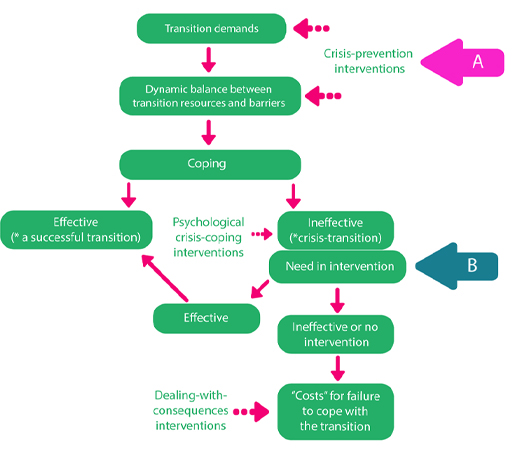3 The athletic career transition model
At times, theory can seem removed from practice, but theory can allow us to develop a better understanding of a concept and help predict what may happen in different situations.
Within the topic of career transitions, various frameworks have been used to explain the athlete’s journey. Perhaps the most useful theory when it comes to exploring transitions is the ‘athletic career transition model’ (Alfermann and Stambulova, 2007). This model views a career transition as a process that creates a potential conflict between what the athlete is and what the athlete wants to be, which requires a coping response. This coping response is either effective, leading to a successful transition, or ineffective, leading to a difficult (‘crisis’) transition. Video 2 shows the different stages of the athletic career transition model and the points at which intervention (which you will learn about in more detail later) can occur to increase the chances of a successful experience.

Transcript: Video 2
This model is helpful as it allows some predictions to be made in terms of how successful a transition will be for an athlete, something you look at in the next activity.
Activity 3 Applying the athletic career transition model
Read the case study below and consider how the athletic career transition model could be applied:
- to help describe Jack’s experience of his transition so far, and
- to help Jack experience an effective transition.
Jack is a talented young rugby player who has recently secured a contract at a professional rugby club. The club is 70 miles away from Jack’s home town and, a few weeks after moving, Jack is feeling very homesick. This is the first time he has lived away from his parents and he is feeling isolated and lonely. He is also finding his new training regime very daunting. He is training more frequently and intensely than he has previously and has doubts about his ability to cope with life at his new club.
Discussion
In applying the athletic career transition model to this case study you may have felt that there is potentially an imbalance between Jack’s transition resources and the transition barriers he is facing, resulting in him finding it difficult to cope with the move to a new club (i.e. the barriers outweigh the resources).
Applying the model could help Jack to experience a successful transition. If someone − perhaps a coach − at Jack’s new club recognised that he was experiencing a crisis transition they could apply an intervention − for example, speak to a psychologist − to help him develop his coping skills. (Interventions to help athletes cope with career transitions are discussed later in this course). Failure to apply an intervention to help Jack cope with the transition could have several ‘costs’ for him, such as underperformance, anxiety or, if things were to develop, depression.
You have been introduced to only one model within this section but you should already be able to see how even a relatively simple model can help give you more insight into athletic transitions.
In the final section of Session 1, you will start to look at some of the components raised in the athletic career transition model and how research has sought to develop our understanding of this topic.
